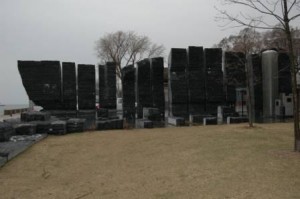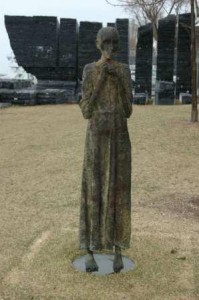Opened in 2007, Toronto’s Ireland Park commemorates Ireland’s large immigrant influx to Canada in 1847.
Situated at 5 Eireann Quay, Ireland Park, like other memorials scattered along the coast of the St. Lawrence River and Lake Ontario, stands eerily abandoned, and seemingly insignificant amidst luxurious condos and towering industrial silos at the foot of Bathurst Street on the lakeshore. Jets fly overhead as they land and depart from the Toronto Island Airport just a stone’s throw away.
While the modes of transportation may have changed, locals, visitors, and newcomers alike, still use Lake Ontario as their gateway to the world.
Ireland Park quietly and humbly honours the tens of thousands of Irish immigrants who died from the “fever” the summer of 1847, fleeing persecution, starvation and poverty in their beloved Eire.
These piteous immigrants considered themselves lucky. They had survived the harrowing trip to the “New World” unlike the thousands who died onboard “coffin” ships. But these brave souls had no guarantee they would live to see their dreams realized once they set foot on our fair shores. Every day the dreaded “fever” hung over them like a sallow beckoning to death
.These memorials remind us that while the masses of wretched humanity may have made it to our water’s edge, thousands died before they were given a chance to live.

A Formation of Stones Resembling an Immigrant Ship in Ireland Park Memorial, Toronto, Ontario © Barbara Dickson
Barbara and her husband thought it fitting that they should visit the Park on a bleak, rainy, cold spring day. The gloomy weather matched the park’s melancholy mood. It wasn’t hard to imagine desperate tears, hunger’s bite, fever’s fiery touch, and the utter hopelessness felt by 40,000 people who disembarked that fateful summer as we walked around the small park.
The actual monument – huge granite slabs placed tightly side by side and roughly shaped like a sailing ship – has etched into its stone markers the names of elevent hundred people who died of fever. The memorial at Grosse Île in Québec has a memorial wall like this one as well. Over five thousand died at Grosse Île’s quarantine station the summer of 1847.
We found Toronto’s Irish monument remarkable in several ways. Firstly, each carved name is hidden in between the memorial’s slabs of rock. A casual passerby most likely would not realize the names were there at all. While it’s not clear why the artist chose to remember the 1,100 victims of the Great Famine this way, but it seems to be a testament to the sacredness of the park and to the sanctity of those who perished. It’s as if their memory, so insignificant in life, is too hallowed in death; as if discovering their identities would somehow lessen the gravity of their loss.
Secondly, tucked in amid common Irish names of the day – like Flanagan and McGee – are vague identities of people whose names had not been learned before they died. They are mentioned simply, as “A Widow Hughes” or “A child from the wharf.”
No one has been forgotten. Each soul who had perished on Toronto’s immigration wharf, or in quickly erected quarantine sheds, has been remembered, not only by God, but by man, as well, even when man knew not who they were.
Thirdly, Ireland Park, sitting at the edge of Lake Ontario where the immigration sheds once stood, is not only large enough for visitors to walk around, but one can look east toward the bustling downtown core of Toronto with the CN Tower rising in the distance. Today, Toronto has a skyline pleasing to the eye. It would have looked much different to the Irish who landed on its wharf over 160 years ago.
Fourthly, and most remarkably, heart-rending sculptures by the water’s edge beckon visitors to pause…
…and remember.
No explanations are needed. No words could add to the message. The sunken, hopeless faces tell all…
…starving, pleading, dying.
A visitor may feel disappointed in the Park’s backdrop – stuck in amidst old silos in an industrial part of Toronto, just as its sister memorials are erected in depressed areas in other provinces like Montréal’s Black Rock. But then one considers the fact that Ireland Park is situated where the immigrant wharf actually was located during the mid-1800’s. The wharf during that period in Toronto’s history would have looked as bleak as the Park does today. Those who died, lost their lives either onboard ship, on the wharf, or in quarantine sheds; it makes sense to honour their memory where they first landed.




11 comments for “Ireland Park: Toronto, Ontario”